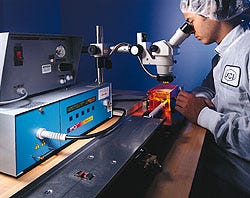January 1, 1998
CASEBOOK
UV Curing Device Plays Integral Role in Bonding Guidewires
Chosen for its reliability, repeatability, and ease of setup
North American physicians perform an estimated 1 million angioplasty procedures each year. Essential to the success of these procedures are guidewires—the rails over which all other devices used in angioplasty must travel. These guidewires are made up of stainless-steel and gold-platinum components bonded together.

C.R. Bard Inc. (Billerica, MA)—a developer, manufacturer, and marketer of cardiovascular, urological, and surgical products—recognized that a comprehensive line of high-quality guidewires would enhance its position in the highly competitive industry.
Traditionally, guidewires have been bonded with welding, brazing, or soldering methods. However, when Bard began developing its Commander platform of guidewires, UV-cured adhesive was the bonding method chosen. Critical to successful adhesive bonding is the reliability and overall quality of the UV-light device employed. With this in mind, Bard chose the Novacure system by EFOS (Mississauga, Ontario, Canada) for bonding its new line of guidewires.
"We had used other lights previously," Bard engineer Paul Marad explains, "but we experienced time-consuming problems. With other lights, for instance, at the beginning of each workday a technician would have to turn on the light, get a reading from a radiometer, and enter the data in a setup logbook. When we're using numerous lights, there's a lot of setup time involved. The Novacure, on the other hand, has its own built-in radiometer for measuring light delivery. In addition, setup is done by the operator. We eliminated technician overhead and increased productivity time," he says.
According to Marad, the EFOS units were easily integrated into Bard's manufacturing fixtures. Using a microscope, the operators position the guidewire components according to built-in indexes, apply adhesive, and spot-cure the joints using the Novacure. Because it has integral self-diagnostic capability, the instrument will alert the operator if any of the preset curing parameters are not met.
Data logging and documentation were also of importance to Bard and its overall quality assurance. "The Novacure has an internal process validation system that provides records showing the bulb number, date, time, accumulated lamp hours—everything we need for continuous repeatability verification," Marad notes.
The Novacure also provides up to 20,000 mW/cm2 of energy, critical during the product development phase. The Novacure unit also features a front-panel control for adjustments. In addition, curing data acquired during development are easily transferred to the manufacturing floor.
Marad concludes that the Novacure system made a significant impact on Bard's overall process. "First, the ease of setup is key in the manufacturing environment. Then there's the continuous monitoring with built-in alarms that allows us to run the process with great confidence. Finally, it's good to know that we are dealing with an ISO-certified supplier that meets GMPs and provides rapid technical responses to developmental or process-oriented inquiries. For us, all of these features add up to value."
For more information on the Novacure system from EFOS, call 905/821-2600.
You May Also Like


